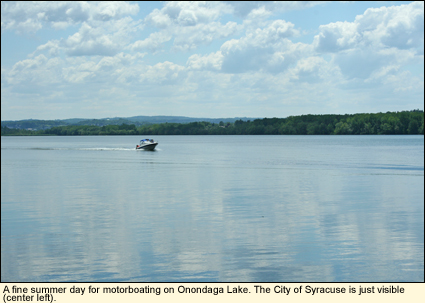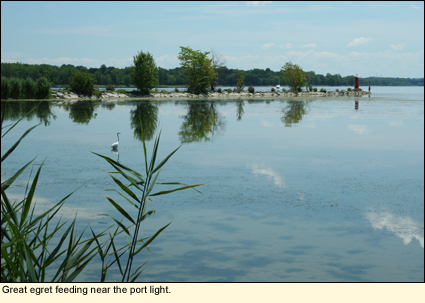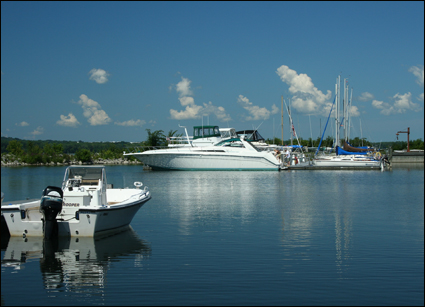Home > Basics > LakesOnondaga Lake
LAKE FLOWOnondaga Lake is 4.7 mi./7.6 km. long, 1.2 mi./2 km. wide and 64 ft./19.5 m. deep. It is a relatively small lake located entirely in the County of Onondaga and close to the City of Syracuse.
The lake flows from south to north and cleans itself four times a year. Onondaga Creek, the inlet to the lake, begins in the Tully Valley in the southern part of Onondaga County. The lake's short outlet, runs into the Seneca River, the waters of which flow eventually into Lake Ontario. The lake is also fed by an number of creeks, including Nine Mile Creek--the outlet of Otisco Lake. Consequently, Otisco Lake drains directly into Onondaga Lake via Nine Mile Creek. HISTORYOnce the center of the Iroquois Confederacy, a replica of a French missionary fort lies within the park boundaries. The Indians would have found just about every species of wildlife historically known to occur in the state around the lake, including otters, wood bison, and eagles. Fish were abundant and migrating waterfowl plentiful. The local Indians trapped and traded with other Indians as well as with Europeans.
At some point, it's not known when or by whom, brine salt was discovered by the Indians below the lake. This was revealed to the American settlers who began producing large quantities of salt from brine along the lake. After the Revolutionary War, the Indians were driven out of their traditional lands. Commercial salt production is thought to have begun in 1793. The Erie Canal, which ran close by, helped transport the salt. Both the canal and the salt production worked to greatly increase the population of the area. During the Civil War, salt production in the Finger Lakes, which provided a major quantity of salt to the North, and the embargoing of salt to the South, was one of the factors that caused the collapse of the South.
A railroad line was put in next to the lake and, as trains were used more and more to transport goods, the use of the canal declined. So too did salt production. Other industries sprang up along and near the lake. In the late 1800s, a number of resorts and beaches could be found around the lake, and people swam in the clean water, and local hotels and restaurants served fish caught in the lake. At the same time, the Solvay Process Company began producing soda ash, and in 1918 it produced organic chemicals, dumping its waste into the Lake. By World War II, swimming was banned on the lake, all the resorts had closed, and the lake became a sewer of industrial and domestic waste.
In the early 1970s one could drive by Onondaga Lake past the smoke stakes of chemical-producing plants and barely be able to breathe the air. The lake was a rainbow of unnatural colors and, if you could see the water at all, as it was often covered with a whitish foam. It wasn't until this time that fishing was banned on the lake.
Since that time, major strides have been made to clean up the lake, contaminated with high levels of mercury, ammonia, phosphorus, salt, and other chemicals. Most of the factories in the area have closed and a domestic waste treatment facility has been built. However, the levels of untreated domestic waste that flow into the lake are still extremely high. (Twenty percent of the lake's water and 90 percent of the lake's ammonia come from this waste treatment facility.) WILDLIFEThe lake is considered a "cold-water" environment, and because of its connection with the Seneca River and Lake Ontario, supports migratory Atlantic salmon, lake sturgeon and turbot. Inventories indicate that 52 species of fish reside in the lake. Pollutants (especially organic wastes) in the water encourage algae growth, which prevents light from reaching native rooted plants that would produce oxygen in the water. As the algae die and sink to the lake bottom, they are broken down by bacteria in the water. This process creates an unnaturally high level of decomposing matter and consumes oxygen, creating "dead" zones. These dead zones have a negative effect on fish populations, which need air to breathe.
Zebra mussels were unintentionally introduced into the lake. They appear to be a mixed blessing. They have filtered out algae and cleaned up the water, but eat a wide variety of lake life that puts them in competition with some fish. On the other hand, diving ducks and some other fish eat them.
The National Audubon Society has designated the lake and its surrounding habitats (deciduous woods and non-tidal wetlands) as an Important Bird Area. During the summer many species breed around the lake. Great egrets, osprey, kingfishers, ring-billed gulls, and other birds eat the fish. Mallards and Canada geese eat vegetation in and around the lake. During migration the lake can see many thousands of waterfowl, five species of gull, and a variety of shore birds. Bald eagles are known to frequent the lake in the winter.
WARNING: According to the New York State Department of Health (DoH), many of the fish in Onondaga Lake are contaminated with mercury, dioxin, and PCBs. The DoH recommends that people eat no walleye, no largemouth or smallmouth bass over 15". It also recommends that people eat no more than one meal per month of all other species. Women of childbearing age and children under the age of 15 should eat none. DoH Advisory ACCESS TO THE LAKEAccess to Onondaga Lake is excellent. Almost all of the land encircling the lake is owned by the county, most of i ACCOMMODATIONSThere are no accommodations in the park of any kind. The entrance to the park is in the Village of Liverpool. Syracuse and Baldwinsville also offer a variety of places to stay. Check the Accommodations Section of this Web site for accommodations in those locations. BOATINGOnondaga Lake is fairly small, and the water is rather calm for sailing to be possible all the time. Canoeing and kayaking are ideal for this lake, but no boats can be rented within the park. Since the lake has direct access to the Seneca River, motorboating is especially popular and, on busy days, can even cause traffic jams where the outlet meets the river. Only kayakers and canoeists who are able to paddle upriver should enter the Seneca as it can have a fairly strong current. MARINA |
|
|


 Onondaga Lake is a lake of contrasts. Considered one of the most polluted lakes in the country, it is surrounded by Onondaga Lake Park, considered one of the country's top national heritage parks. Despite the fact that no one is allowed to have contact with the water and fishing is permitted on a catch-and-release basis only, that doesn't deter a couple of thousand visitors from enjoying the lake and the park on a sunny summer Sunday.
Onondaga Lake is a lake of contrasts. Considered one of the most polluted lakes in the country, it is surrounded by Onondaga Lake Park, considered one of the country's top national heritage parks. Despite the fact that no one is allowed to have contact with the water and fishing is permitted on a catch-and-release basis only, that doesn't deter a couple of thousand visitors from enjoying the lake and the park on a sunny summer Sunday.
